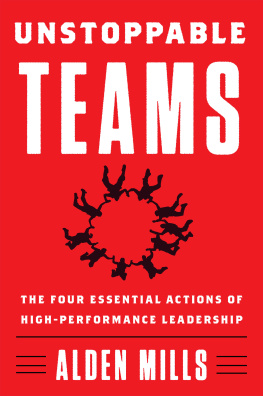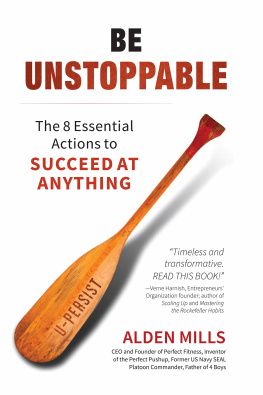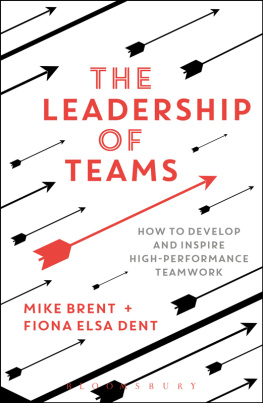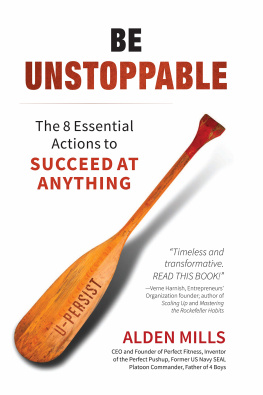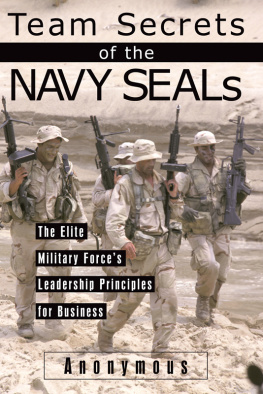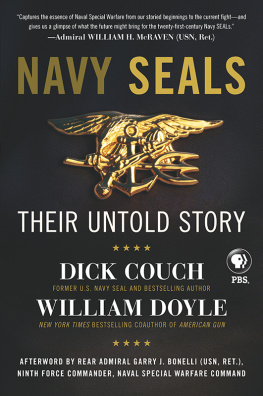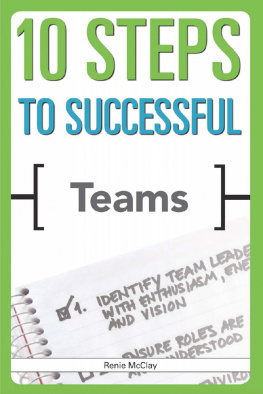Thahs nah room fah Rambos in SEAL Team!
I can still hear Instructor Smith bellowing that sentence in his thick Bostonian accent, a reference to that ultimate badass, John Rambo, who goes on impossible missions deep behind enemy linesall by himselfand wins. To our Navy SEAL instructors at BUD/S (Basic Underwater Demolition/SEAL) school, however, Rambo was a pejorative term for the lone wolf who thinks he can do it all himself. Instructor Smith loved repeating that phrase. Thahs nah room fah Rambos in SEAL Team!
When young men and women who want to join the SEALs first hear about BUD/S, they become obsessed with the grueling physical exertion that lies ahead. But what gets you through the training is a balance of mental, emotional, and physical strength, combined with your greatest asset as a SEAL: the people around you. Instructor Smiths point was clear. Its the team that completes the mission, not some mythical Rambo character.
I know this firsthand: Ive led three SEAL platoons, and Ive experienced the asymmetrical warfare advantage that SEAL Team cultivates. That advantage has served us in vastly different environments, whether hunting for a war criminal deep in the mountains of Bosnia or conducting classified combat mini-submersible operations at night thirty feet underwater with hand signals (squeezes) as our only means of communication. SEAL Team is bound together by a common purpose and a mentality of Ive got your back. We place the success of the team above individual needs because the teams needs come to represent our individual needs, too.
When a small group of people band together to do something extraordinary, the rest of us scratch our heads in wonder. Whether its an unranked basketball team outplaying an undefeated powerhouse or a little-known startup becoming the overnight market leader, David and Goliath stories capture our attention and inspire us. We cheer for successful underdogs, and we even dream about being like thema tightly knit team of ordinary people doing extraordinary things under difficult circumstances. Thats what I mean by an unstoppable team, one that brings diverse gifts to bear on the teams goals through a shared sense of purpose and a deep commitment to each other. You can assemble as many individual superstars as youd like, but they wont become unstoppable unless they believe in each other and in their collective mission.
Unstoppable teams arent reserved for elite forces in the military. In sports, in business, in communities, in every facet of life, developing the qualities of an unstoppable team is essential if you want to thrive in chaos and break away from the pack. It might sound crazy, maybe even superhuman, but its within your reach. You dont have to go through BUD/S to build an unstoppable team, but you would do well to incorporate the lessons of team building that have served the legendary Navy SEALs so well for the last fifty-five-plus years. The actions used by SEALs to build high-performing teams are the same actions required in business, nonprofits, and sport teams.
Unstoppable teams come in all shapes and sizes, but they all depend on understanding human emotions, motivations, and values. It is both complex and as simple as this: you must care. Caring is the cornerstone for building trust and persistence in any group. When people feel cared for and when they care about the tasks and goals at hand, they are willing to step beyond their perceived limits and dare to do something greater than they originally thought possible.
Ive spent the last thirty years daring, failing, and eventually succeeding at building just these sorts of teamsas a member of championship high school and college rowing crews, as a Navy SEAL, as the founder of a successful startup, as a community organizer, and, yes, even as a father and a husband. Though each one of these efforts has had different objectives, they all used the same framework, the same actions, and the same level of all-in commitment. If youre willing to commit to caring for and serving others, then you can become a truly unstoppable force for making greatness happen.
Like several other species, humans are preprogrammed to reciprocate when care is bestowed upon us. Open doors for people, and they will respond by opening other doors for other people. This simple act of reciprocity is part of the essential chain reaction that unstoppable teams depend on. Caring unites the head with the heart. However, Im not talking about simple acts of kindness (though those are essential too); Im talking about giving your full, authentic commitment to putting others above yourself. Thats easier to do when the horizon is clear of danger, but when times get tough, our instinct is to protect ourselvesto seek the cave of safety when the proverbial T. rex is chasing us. But if youre able to show care for others only from the safety of your comfy sofa (so to speak), theres no way you can possibly lead an unstoppable team. Unstoppable teams thrive in uncertainty, and lets face it, change and uncertainty are far more common than wed all like.
So how do you get people to step outside the safety of their self-interests to join an unstoppable team? From experience and from training, Ive identified four actionsconnect, achieve, respect, and empowerthat, taken together, lie at the heart of every great team. I call it the CARE loop. When these four acts of caring are activated, anything is possible. Its no coincidence that military strategists consider SEALs (and other military special forces) to be force multipliers ten times more effective than conventional troops. Moreover, this extreme team dynamicwhat I call the 10x advantageis not unique to SEAL Teams. It can be harnessed by any well-constructed and highly functioning small team. I have experienced it as a startup founder of one of the fastest-growing consumer-products companies in the country. Much like a SEAL Team, my companys power derived from a handful of people, each with a diverse background and skill set, who went all in on a shared objective: make our core product (the Perfect Pushup device) a category-defining one. The results were staggering: our team created a business that generated nearly $100 million in revenue in just two years and competed against businesses ten times its size.
I also experienced the 10x advantage in sports, as I participated on championship rowing teams in both high school and college. In competitive rowing, arguably the most team-focused sport there is, the difference between winning and losing depends completely on the team performance of eight rowers pulling perfectly in sync. When I rowed for the US Naval Academy, our crews were predominantly first-time rowers, while the boats of our Division 1 competitors were full of experienced oarsmen (and oarswomen). Yet we routinely competed for championships. We owed this to our ability to build better teams.
Imagine for a moment that you are surrounded by people who will not let you fail. When you see an obstacle, they see an opportunity. When youre scared, they turn to support you. When youre tired, they work tirelessly. When youre uncertain, they reassure you. In short, they make you feel unstoppable. I know this feeling, because Ive experienced it time and time again, from the battlefield to the boardroom. Youre unstoppable because you share energy that fortifies and focuses each of you, multiplies your strengths, and diminishes your weaknesses.
If you want to be a great team builder, then you need to learn to become a great relationship builder first. It starts with you. In the next chapter, I will discuss the foundational component of every great team: you and the team inside of you. Before you can begin to inspire and influence others, you must know yourself and figure out what matters to you. Your first team is the only team you can control. In SEAL Team, they call that team your weapons platform; I call it your action platform. Do you think youll be able to influence, inspire, and convince others to join your quest to accomplish something if you dont come across inspired and convincing? You must first learn to master your own thinking, feelings, and behavior.

